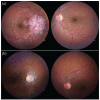Acute lymphoblastic leukemia relapse presenting with optic nerve infiltration
- PMID: 37250823
- PMCID: PMC10214062
- DOI: 10.1177/2050313X231175020
Acute lymphoblastic leukemia relapse presenting with optic nerve infiltration
Abstract
Acute lymphoblastic leukemia is the most common childhood malignancy. Despite many advances in therapy, about 15%-20% of children with acute lymphoblastic leukemia experience a disease relapse. Isolated ocular relapse is relatively rare. A 14-year-old male with T-cell acute lymphoblastic leukemia in remission presented with sudden onset of right eye pain and visual acuity impairment. Fundoscopic examination of the eye and magnetic resonance imaging of the orbits were consistent with optic nerve infiltration. The patient was treated with salvage chemotherapy, orbital radiation and eventual bone marrow transplantation, with notable improvement in vision and regression of retinal and optic nerve findings. Optic nerve infiltration represents an ophthalmic emergency and requires urgent management. The use of radiation therapy is a helpful adjunct with systemic chemotherapy in obtaining disease remission.
Keywords: Acute lymphoblastic leukemia; optic nerve infiltration; radiation therapy; salvage treatment.
© The Author(s) 2023.
Conflict of interest statement
The author(s) declared no potential conflicts of interest with respect to the research, authorship and/or publication of this article.
Figures


References
-
- Linabery AM, Ross JA. Trends in childhood cancer incidence in the U.S. (1992-2004). Cancer 2008; 112(2): 416–432. - PubMed
-
- Hunger SP, Mullighan CG. Acute lymphoblastic leukemia in children. N Engl J Med 2015; 373(16): 1541–1552. - PubMed
-
- Goto H. Childhood relapsed acute lymphoblastic leukemia: biology and recent treatment progress. Pediatr Int 2015; 57(6): 1059–1066. - PubMed
-
- Rosenthal AR. Ocular manifestations of leukemia. A review. Ophthalmology 1983; 90(8): 899–905. - PubMed
Publication types
LinkOut - more resources
Full Text Sources

